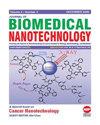新型脂质体纳米颗粒通过 miR-16 靶向自噬微管相关蛋白 1A/1B-Light Chain 3 家族抑制胶质瘤的分子机制
IF 2.9
4区 医学
Q1 Medicine
引用次数: 0
摘要
miR-16和其他几种已知的致癌基因共存于多种实体瘤中,并在许多肿瘤中发挥致癌作用。本研究探讨了 miR-16 是否调控自噬的表达,并分析了靶向纳米粒子干预在胶质瘤中的作用。研究还评估了正常淋巴细胞、低转移性胶质瘤和高转移性胶质瘤细胞系中的miR-16和LC3表达情况。胶质瘤细胞系 U251 用于检测和比较 LC3 的表达。流式细胞仪检测细胞增殖,Transwell检测细胞侵袭和转移的数量。胶质瘤组织中的 LC3 mRNA 明显增加。肿瘤结节转移(TNM)分期越晚,miR-16的表达量越低,LC3的表达量越高,这与TNM分期有关。胶质瘤细胞中 LC3 mRNA 明显高于正常细胞,而 miR-16 则低于后者。胶质瘤细胞系 U251 中 LC3 的表达量较高,而 miR-16 的表达量较低。转染 siRNA-LC3 和靶向纳米粒子能有效下调胶质瘤细胞株 U251 中 LC3 的水平。总之,miR-16与LC3表达的增加以及胶质瘤细胞侵袭和转移能力的增强有关。本文章由计算机程序翻译,如有差异,请以英文原文为准。
Molecular Mechanism of Inhibition of Glioma by Targeting Autophagy Microtubule-Associated Protein 1A/1B-Light Chain 3 Family via miR-16 with Novel Liposome Nanoparticles
MiR-16 and other several known oncogenes co-exist in various solid tumors and play carcinogenic roles in many tumors. This study explores whether miR-16 regulates autophagy expression and analyzes the role of targeted nanoparticle intervention in glioma. miR-16 and LC3 expressions were examined by reverse transcription-polymerase chain reaction (RT-PCR). They were assessed in normal lymphocytes, low-metastatic glioma, and high-metastatic glioma cell lines as well. The glioma cell line U251 was used to detect and compare the expression of LC3. Flow cytometry detected cell proliferation and the number of cell invasion and metastasis was detected by Transwell. LC3 mRNA in glioma tissues was evidently increased. The later the Tumor Node Metastasis (TNM) stage, the lower expression of miR-16 and the higher expression of LC3, which is related to TNM stage. LC3 mRNA in glioma cells was obviously higher than normal cells while miR-16 was lower than the latter. The expression of LC3 in glioma cell line U251 was higher, while miR-16 was lower. Transfection of siRNA-LC3 and targeted nanoparticles could effectively down-regulate the level of LC3 in the glioma cell line U251. In conclusion, miR-16 is related to the increased expression of LC3 and the enhanced ability of glioma cells to invade and metastasize.
求助全文
通过发布文献求助,成功后即可免费获取论文全文。
去求助
来源期刊
CiteScore
4.30
自引率
17.20%
发文量
145
审稿时长
2.3 months
期刊介绍:
Information not localized

 求助内容:
求助内容: 应助结果提醒方式:
应助结果提醒方式:


